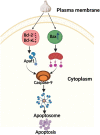Updates on the anticancer potential of garlic organosulfur compounds and their nanoformulations: Plant therapeutics in cancer management
- PMID: 37021043
- PMCID: PMC10067574
- DOI: 10.3389/fphar.2023.1154034
Updates on the anticancer potential of garlic organosulfur compounds and their nanoformulations: Plant therapeutics in cancer management
Abstract
Garlic (Allium sativum L.) possesses numerous pharmacological potential, including antibacterial, antiarthritic, antithrombotic, anticancer, hypoglycemic, and hypolipidemic effects. The anti-cancer action of garlic is likely the best researched of the many advantageous pharmacological effects, and its use offers significant protection against the risk of developing cancer. A few active metabolites of garlic have been reported to be essential in the destruction of malignant cells due to their multi-targeted activities and lack of significant toxicity. The bioactive compounds in garlic having anticancer properties include diallyl trisulfide, allicin, allyl mercaptan diallyl disulfide, and diallyl sulphide. Different garlic-derived constituents and their nanoformulations have been tested for their effects against various cancers including skin, ovarian, prostate, gastric, breast, and lung, colorectal, liver, oral, and pancreatic cancer. The objective of this review is to summarize the antitumor activity and associated mechanisms of the organosulfur compounds of garlic in breast carcinoma. Breast cancer continues to have a significant impact on the total number of cancer deaths worldwide. Global measures are required to reduce its growing burden, particularly in developing nations where incidence is increasing quickly and fatality rates are still high. It has been demonstrated that garlic extract, its bioactive compounds, and their use in nanoformulations can prevent breast cancer in all of its stages, including initiation, promotion, and progression. Additionally, these bioactive compounds affect cell signaling for cell cycle arrest and survival along with lipid peroxidation, nitric oxide synthase activity, epidermal growth factor receptor, nuclear factor kappa B (NF-κB), and protein kinase C in breast carcinoma. Hence, this review deciphers the anticancer potential of garlic components and its nanoformulations against several breast cancer thereby projecting it as a potent drug candidate for efficient breast cancer management.
Keywords: cancer; drug delivery; garlic; molecular mechanism; nanoformulations; organosulfur compounds; plant therapeutics.
Copyright © 2023 Pandey, Khan, Alshammari, Saeed, Aqil and Saeed.
Conflict of interest statement
The authors declare that the research was conducted in the absence of any commercial or financial relationships that could be construed as a potential conflict of interest.
Figures
References
Publication types
LinkOut - more resources
Full Text Sources
Research Materials


